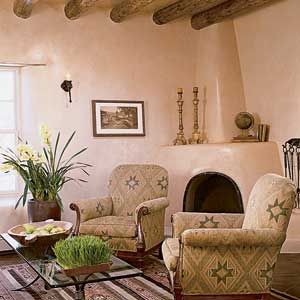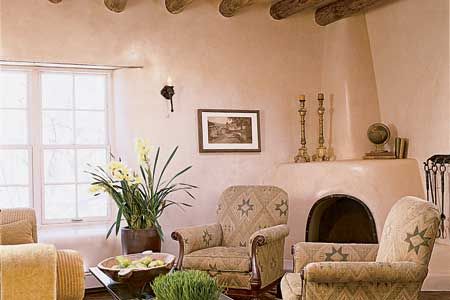
Thanks to a combination of careful upkeep and luck, the adobe walls of the Canyon Road house in Santa Fe, New Mexico, were in remarkable shape when contractors removed the windows, doors, and roof. But had moisture found its way in—typically either via poor drainage at the footing or a crack in the plastered roof parapets—some restoration would be in order.
Among purists, that means a call to Ed Crocker. The historic-preservation contractor is renowned throughout the Southwest for his work with earthen materials, including so-called “true adobe” (that is, bricks made without asphalt additives) and mud plaster.
Crocker and his crew first strip off an adobe wall’s existing—typically cement-based—plaster to assess its condition. He’ll patch eroded areas with adobe “batts,” small sections of premade mud bricks (seen at left) that are broken with a hatchet to the needed size. Using these batts together with mud mortar, Crocker then rebuilds the wall.
The next step is a new coat of plaster, and though most clients specify cement, fearing maintenance issues, Crocker lobbies hard for earth. “We prefer mud plaster because it is vapor-permeable, allowing moisture to escape.” The mix must be 20 percent clay and 80 percent aggregate, which can range from simple masonry sand all the way up to 3/8- or ½-inch gravel. Ordinary straw is also a key ingredient; Crocker chops it into pieces up to 1½ inches long. He adds it to the mix, then carefully trowels it onto the wall with horizontal strokes to align the straw pieces horizontally on the surface. This orientation is key; it forces rainwater to sheet down the wall, rather than create channels, which eventually eat into the plaster. “When the straw is parallel to the ground, water running down the wall splits and doesn’t create a rivulet,” he says. Finally, Crocker and his team break capillary action along the foot of the wall with a 12-inch-wide strip of polypropylene covered with filter fabric. Attached along the bottom of the wall just below grade, the material conducts water away from the footing through a drainage pipe.
In most cases, the ancient earthen materials do the job better than modern ones; Crocker warranties his mud plaster for up to 10 years—better protection than what’s given for most cement-based stucco finishes in Santa Fe.

